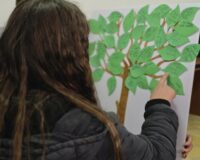++ The grup of scientists from Albania and Austria assess the delta of the Vjosa river ++ The data will highlight the values of the delta in function of its inclusion in the Vjosa national park of Vjosa++
Narta, Vlora, April 24-28, 2023. An interdisciplinary team of national and international scientists, from Albania and Austria, with different fields of research, assessed the biodiversity, geology, and physic-chemical conditions of the Vjosa river and delta, aiming to highlight the natural values of the delta. The research on the site continued for one week with scientists and experts from public institutions, as National Agency for Water Resources Management (AMBU), Regional Agency of Environment Fier (RAE Fier), Regional Administration of Protected Areas Vlorë and Fier (RAPA Vlorë).
Professor Aleko Miho from Faculty of Natural Sciences, UT, one of the main organizers of the Vjosa Science Week, says: “The purpose of the Scientific Week this month was to get to know the situation today, to collect data on biodiversity, hydrogeology, geography, etc and to be presented in a scientific report as well as for public interest. In addition to the scientific contribution on natural values, judgments will be given on the level of sensitivity and their threat, this will help decision-making, policy-making, investors, and other interested parties of the area.
“The scientific week in the Delta of Vjoses confirmed its extraordinary richness in biological diversity, expressed in the high number of habitats and plant and animal species it hosts, including here endemic species, such as the Albanian frog (Pelophylax shqipericus), species protected by international conventions such as otters (Lutra lutra), migratory species of water birds such as Plegadis falcinellus, Calidris ferruginea, Larus genei, or nesting water birds such as Sterna hirundo, Sterna albifrons, Himantopus himantopus, Hematopus ostralegus, Recurvirostra avosetta, Tadorna tadorna, Burhinus oedicnemus, etc. Although it is the breeding season for the Dalmatian Pelican (Pelecanus crispus) and most of them are in this period of the year in the lagoon of Karavatsa, the Vjosa delta and Narta lagoon keep a part of non-reproducing individuals of this emblematic species for our country” says Professor Ferdinand Bego, vice Dean of Faculty of Natural Sciences, UT.
The scientists covered the most important parts of the Vjosa river’s delta including: the Protected Landscape Pishë Poro-Nartë, Mifoli bridge, Lumi i vdekur, Dellinjë, Kallenga lagoon, Darzezë, “Pylli i sodës” and Zvërneci island.
“Our opinion is that the area of the Vjosa Delta from Darëzeza (Fier) to Narta Lagoon (Vlora) should be left free, untouched by construction projects. It is even the right moment for a good part of the Pishë Poro-Nartë Protected Landscape to become part of the Vjosa River PA with which they form an indivisible hydrodynamic and ecological unity”, added prof. Miho.
While prof. Bego, adds” The delta of Vjosa, the salt marshes and the Narta lagoon hold the largest population of flamingos (Phoenicopterus roseus) in our country, with over 2,000 individuals. The numerous natural and semi-natural habitats of the Vjosa delta serve as important feeding grounds for 13 species of bats, all of which are protected by the Bern Convention”.
The Vjosa science week has now become a tradition, bringing together different groups of experts who conduct interdisciplinary research throughout the Vjosa basin. This year the focus was the Vjosa river mouth and delta.











